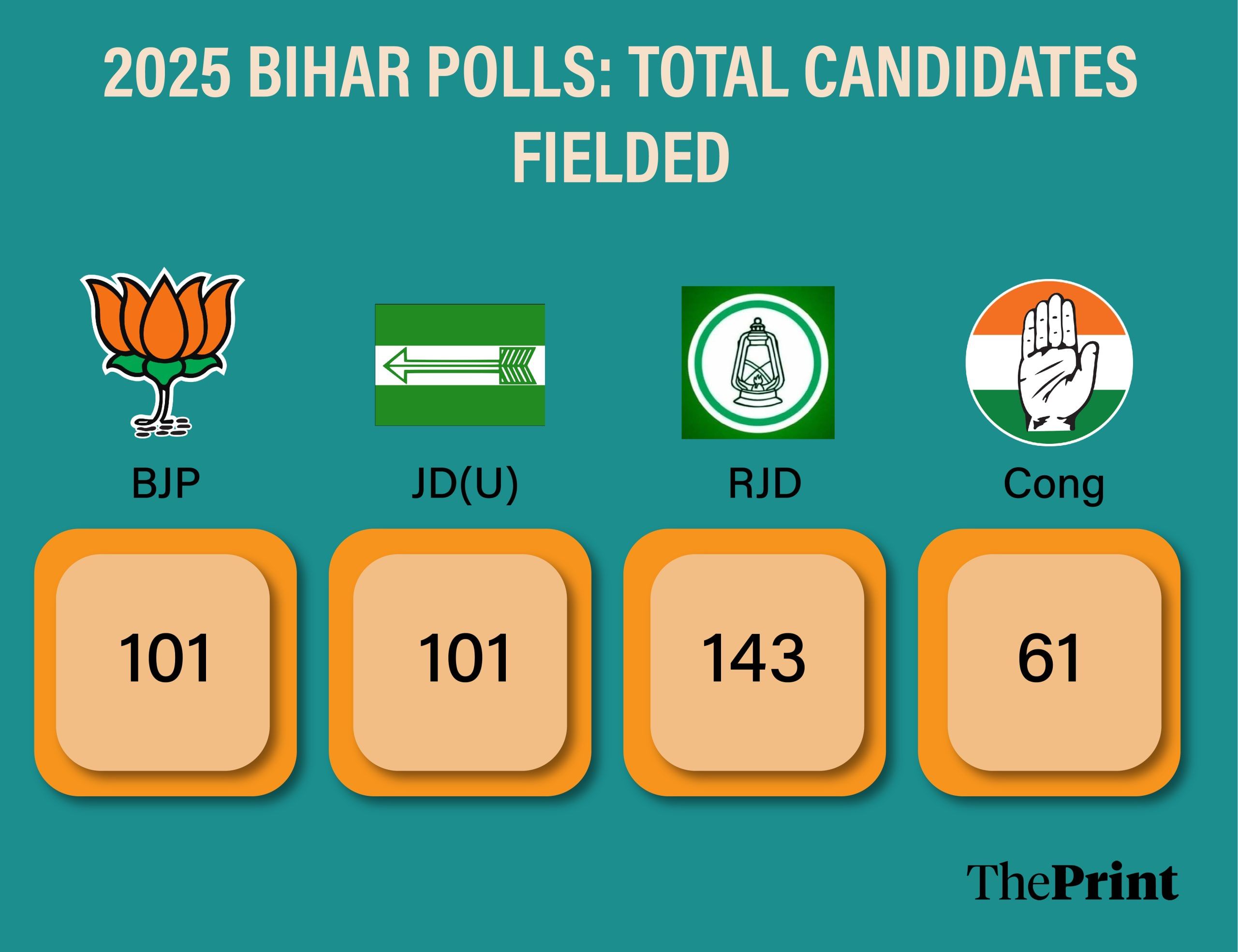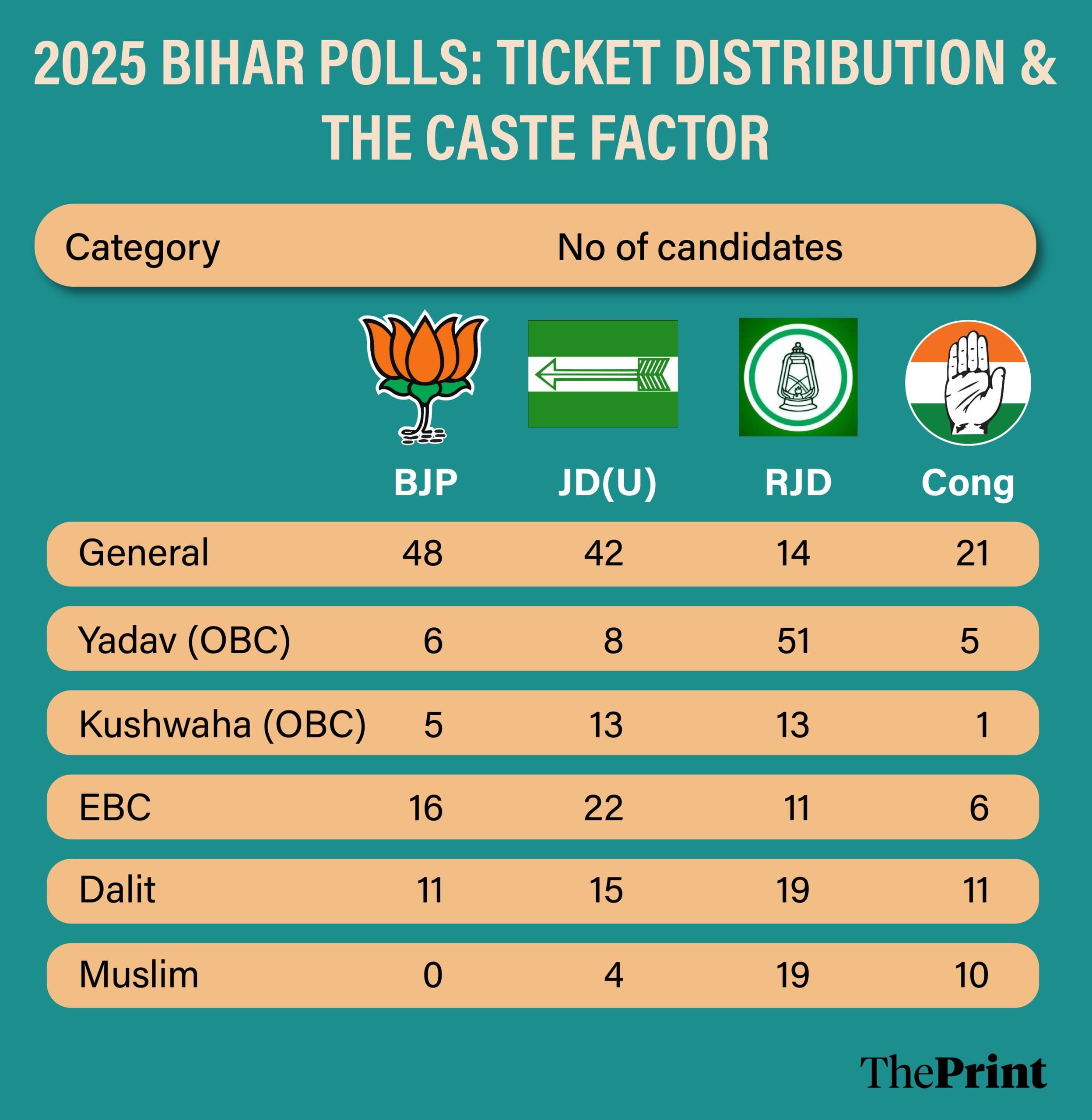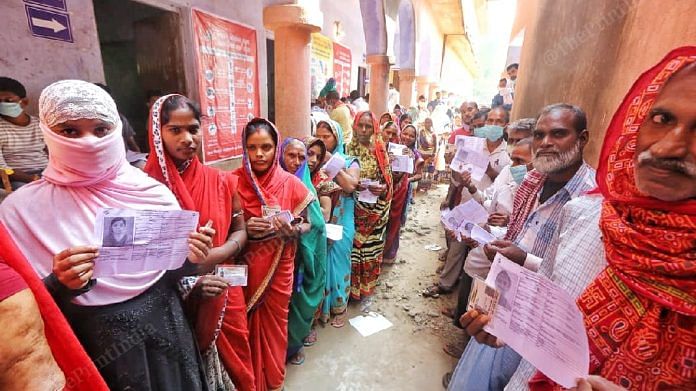New Delhi/Lucknow: As Bihar gears up for the assembly elections next month, there is a sense of political déjà vu in the state. With caste equations and social engineering playing a crucial role, most parties, from the BJP and JD(U) to the RJD, are sticking to tried-and-tested formulas that have shaped the state’s political landscape for decades.
Chief Minister Nitish Kumar’s Janata Dal (United) is leaning on Backward Classes (BCs) and Extremely Backward Classes (EBCs) as it seeks to return to power in the polls scheduled to be held in two phases on 6 November and 11 November.
The Bharatiya Janata Party (BJP) is still betting on its upper caste base, while the Rashtriya Janata Dal (RJD), led by Tejashwi Yadav, is banking on its traditional Muslim-Yadav vote bank.
The distribution of tickets reflects how the parties have not strayed from their traditional support base.
The BJP has allocated nearly 48.5 percent of its tickets to upper-caste candidates, while the RJD has given 49 percent of its tickets to its traditional Muslim-Yadav base.
The BJP, which is contesting 101 of Bihar’s total 243 seats, has given 49 tickets to upper castes, with Rajputs receiving 21, Bhumihars 16, Brahmins 11 and Kayasthas one. In contrast, RJD has given 51 tickets to Yadavs and 19 to Muslims, out of the 143 seats it is contesting this time.
In 2020, the BJP had given 52 tickets to upper castes, whereas the RJD had given 76 to Muslims and Yadavs.
Though MP Rahul Gandhi spoke about caste census during his Voter Adhikar Yatra in the state, the Congress, RJD’s partner in the Mahagathbandhan, seems to be relying more on the upper caste category in ticket distribution. The party has allotted 21 tickets to general category candidates and 19 to OBCs, including six to EBCs.
On Thursday, as the alliance named Tejashwi Yadav its chief ministerial pick, Vikassheel Insaan Party chief Mukesh Sahani, an EBC leader, was declared the Deputy CM face.

Also Read: In Bihar, smaller allies seek greater pound of flesh. NDA, Mahagathbandhan feel coalition pangs
‘Experiments rarely succeed in Bihar’
Bihar-based political experts say parties in the state usually avoid major experiments in ticket distribution.
“In Bihar, the tried-and-tested formulas usually work. Lalu knows that Muslims and Yadavs connect with him, so he prefers to rely on them, while the BJP’s inclination toward upper castes is quite evident,” N.K. Chaudhary, a retired faculty member of Patna University, told ThePrint.
He added that unlike Uttar Pradesh, Bihar has a different caste dynamic, where new experiments rarely succeed, prompting parties to stick to traditional social engineering while distributing tickets.
Nitish experimented a couple of decades ago by relying more on EBCs, but even he is now treading carefully and sticking to his traditional base, he explained.
Following the traditional pattern of promising to empower BCs and EBCs, the JD(U) has given the highest representation to candidates from these categories for this election.
Of its 101 candidates, 37 belong to BCs and 22 to EBCs. Overall, the JD(U) has allotted 59 tickets to OBC (Other Backward Classes) candidates. In the 2020 elections, the combined number of OBC and EBC candidates was also 59, though the share of EBCs was about 6 percent higher last time.
This year, the JD(U) has 13 candidates from the Kushwaha community, and 12 from the Kurmi community. It has also fielded eight Yadav candidates.
Once known as the “Lav-Kush” party—with “Lav” representing the Kurmis and “Kush” representing the Kushwahas—the JD(U)’s caste-wise candidate selection continues to reflect this identity.
However, the representation of Yadavs has declined notably. In 2020, the party fielded had 18 Yadav candidates, of whom seven had won. This time, only eight Yadavs have been fielded.
Among EBCs, the party has given seven tickets to the Dhanuk, three to Malhas, two each to Telis, Kulahiya Muslims, Kamats and Gangotas, and one each to the Kanu, Halwai and Gaderiya communities.
While the BJP’s focus remains on its upper caste base, its candidate list also included 24 backward class nominees and 16 EBCs. Among the backward class candidates, six are Yadavs. In 2020, the BJP had given tickets to 16 Yadavs. Among other OBC candidates, five are Kushwahas, two Kurmis, four Vaish, three Kalwars, three Sudhis, one Marwari and one Chanau.
Within the EBC category, the party has fielded five candidates from the Teli community; one each from the Nishad, Kevat, Bind and Dhanuk castes; three from the Kanu caste; and one each from the Noniya, Chandravanshi, Dangi and Chaurasia castes.
In RJD’s candidate list, apart from Muslims, the party is banking on the Kushwahas among backward classes, fielding 13 candidates from the community. Among upper castes, the RJD has fielded 14 candidates, compared to 23 in the previous election.
Gyanendra Yadav, a faculty member of the Political Science department at Patna College of Commerce, Arts and Science, said, “Except for slight changes in the EBC quota, most parties have followed a similar ticket distribution pattern this time. The reason lies in their reliance on traditional caste equations.”
He added, “Although there was speculation that the RJD might adopt a Samajwadi Party-style social engineering approach to woo more non-Yadav OBCs, the party ultimately stuck to its old formula. This indicates that Tejashwi wants to maintain the traditional pattern, while also focusing more on Kushwahas and upper castes, not just through tickets, but by giving them greater representation in party positions as well.”

Wooing the Kushwahas
The Kushwaha community, an influential OBC group in Bihar, has emerged as one of the most favoured caste groups in this election’s ticket distribution, with more than three dozen nominations across parties.
The RJD has given 13 tickets to candidates from this community, while the JD(U) has allotted 13. Even the left Communist Party of India (Marxist-Leninist) has given five tickets to Kushwahas.
“The Kurmi, Kushwaha, Maurya and Koeri communities are considered closely related within the OBC category. Apart from Yadavs, most parties tend to rely on these groups, which have been historically associated with agriculture but are now very influential after Yadavs in Bihar,” said Chaudhary. “As per the last two decades’ trend, JD(U) got their support. This time, opposition parties are also trying to woo them.”
(Edited by Sugita Katyal)
Also Read: How Amit Shah is putting out fires & steering BJP’s electoral battle in Bihar







Upper castes make only 10% of bihar’s population while yadav muslim make around 32% of the state population. So the 49% seats to 32% is as one sided as the ratio is 1.5 times while 48% seats to 10% is clearly one sided, seats allotment almost 5 times their population. This shows BJP has no presence among the masses just obtains votes by lies and divide and rule